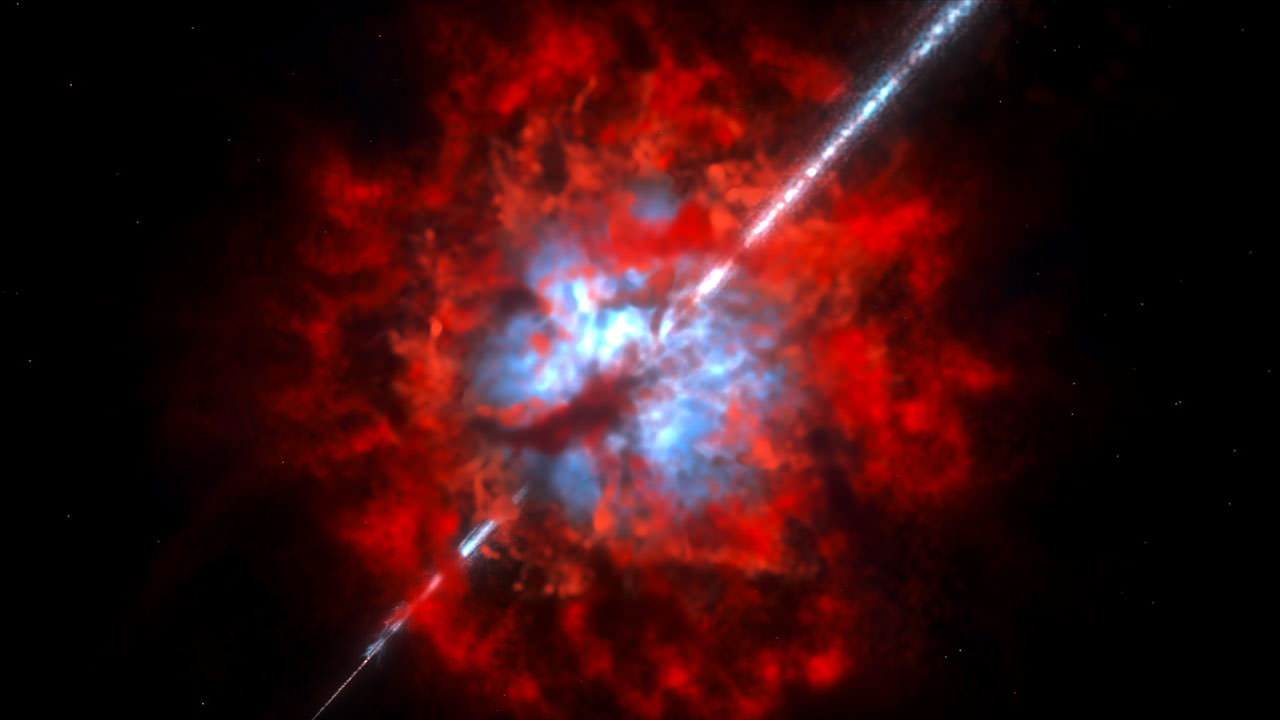Gamma-ray bursts (GRBs) represent the most powerful explosions in the cosmos, sending out as much energy in a matter of seconds as our Sun will give off during its entire 10-billion-year lifespan.
These powerful explosions are thought to be triggered when dying stars collapse into jet-spewing black holes. Yet no one has ever witnessed a GRB directly. Instead astronomers are left to study their fading light.
But some GRBs mysteriously seem to have no afterglow. Now, observations from the Atacama Large Millimeter/submillimeter Array (ALMA) are shedding light on these so-called dark bursts.
One possible explanation is that dark bursts explode so far away their visible light is extinguished due to the expansion of the Universe. Another possible explanation is that dark bursts explode in galaxies with unusually thick amounts of interstellar dust, which absorb a burst’s light.
Neither explanation, however, seems likely as astronomers anticipate that GRB progenitors — massive stars — are found in active star-forming regions surrounded by large amounts of molecular gas. But unfortunately there has never been an observational result to back up this theory either.
So astronomers have been working hard to better understand GRBs by studying their host galaxies. Now, a Japanese team of astronomers led by Bunyo Hatsukade from the National Astronomical Observatory in Japan, has used ALMA to report the first-ever map of molecular gas and dust in two galaxies that were previously rocked by GRBs.
Hatsukade and colleagues detected the radio emission from molecular gas and dust in two dark host galaxies — GRB 020819B and GRB 051022 — at about 4.3 billion and 6.9 billion light-years away, respectively.
“We have been searching for molecular gas in GRB host galaxies for over 10 years using various telescopes around the world,” said Kotaro Kohno from the University of Tokyo in a press release. “As a result of our hard work, we finally achieved a remarkable breakthrough using the power of ALMA. We are very excited with what we have achieved.”
Watch the video below for an artist concept animation of the environment around GRB 020819B based on ALMA observations:
The telescope’s high sensitivity enabled the team of astronomers to detect the emission from molecular gas, as opposed to most telescopes, which can only probe absorption along the line of sight. This combined with its high spatial resolution provided the first detailed map of the molecular gas and dust throughout a GRB host galaxy.
Surprisingly, less gas was observed than expected, and correspondingly much more dust. The ratio of dust to molecular gas at the GRB site is 10 times higher than in normal environments.

“We didn’t expect that GRBs would occur in such a dusty environment with a low ratio of molecular gas to dust,” said Hatsukade. “This indicates that the GRB occurred in an environment quite different from a typical star-forming region.”
The research team thinks the high proportion of dust compared to molecular gas is likely due to the intense ultraviolet radiation from the young, massive stars, which will break up any molecular gas while leaving the dust relatively undisturbed.
It’s becoming clear that dust absorbs the afterglow radiation, causing these dark gamma-ray bursts. The team plans to carry out further observations and is excited to use ALMA’s incredible sensitivity to probe other host galaxies.
The results are published today in the journal Nature. You can read more from the National Radio Astronomy Observatory and ESO.


makes perfect sense.